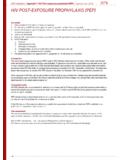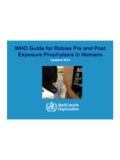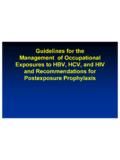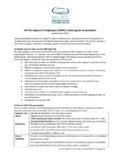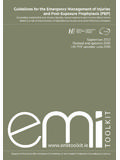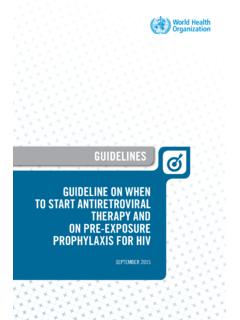Transcription of r
1 Please note: These guidelines have been updated. To view the update, please click here. Morbidity and Mortality Weekly Report Recommendations and Reports September 30, 2005 / Vol. 54 / No. RR-9. Updated public health Service guidelines for the Management of Occupational Exposures to HIV and Recommendations for postexposure prophylaxis INSIDE: Continuing Education Examination depar tment of health and human ser department vices services Centers for Disease Control and Prevention MMWR. CONTENTS. The MMWR series of publications is published by the Coordinating Center for health Information and Service, Introduction .. 1. Centers for Disease Control and Prevention (CDC), Department of health and Human services , Atlanta, GA 30333. Definition of health -Care Personnel and Exposure.
2 1. Risk for Occupational Transmission SUGGESTED CITATION of HIV .. 2. Centers for Disease Control and Prevention. Updated Antiretroviral Agents for PEP .. 2. public health Service guidelines for the management of occupational exposures to HIV and recommendations for Antiretroviral Drugs During Pregnancy .. 7. postexposure prophylaxis . MMWR 2005;54(No. RR-9): Management of Occupational Exposure by Emergency [inclusive page numbers]. Physicians .. 7. Occupational HIV Exposure Management and PEP Use in Centers for Disease Control and Prevention Hospitals .. 7. Julie L. Gerberding, MD, MPH Recommendations for the Management of HCP Potentially Director Exposed to HIV .. 8. Dixie E. Snider, MD, MPH HIV PEP .. 8. Chief Science Officer Recommendations for the Selection of Drugs for HIV PEP.
3 8. Tanja Popovic, MD, PhD Follow-Up of Exposed HCP .. 9. Associate Director for Science Reevaluation and Updating of HIV PEP guidelines .. 11. Coordinating Center for health Information Acknowledgments .. 11. and Service References .. 11. Steven L. Solomon, MD. Continuing Education Activity .. CE-1. Director National Center for health Marketing*. Jay M. Bernhardt, PhD, MPH. Director Division of Scientific Communications*. Maria S. Parker (Acting) Director Mary Lou Lindegren, MD. Editor, MMWR Series Suzanne M. Hewitt, MPA. Managing Editor, MMWR Series Teresa F. Rutledge (Acting) Lead Technical Writer-Editor Jeffrey D. Sokolow, MA. Project Editor Beverly J. Holland Disclosure of Relationship Lead Visual Information Specialist CDC, our planners, and our content experts wish to disclose they Lynda G.
4 Cupell have no financial interests or other relationships with the Visual Information Specialist manufacturers of commercial products, suppliers of commercial services , or commercial supporters. Quang M. Doan, MBA. Erica R. Shaver The antiretroviral agents mentioned in the article do not have an Information Technology Specialists approved indication by the FDA for postexposure prophylaxis . The * Proposed. material presented is based on expert review and does not reflect the views of the FDA. Vol. 54 / RR-9 Recommendations and Reports 1. Updated public health Service guidelines for the Management of Occupational Exposures to HIV and Recommendations for postexposure prophylaxis Prepared by Adelisa L. Panlilio, MD1. Denise M. Cardo, MD1. Lisa A.
5 Grohskopf, MD2. Walid Heneine, PhD2. Clara Sue Ross, MD3. 1. Division of Healthcare Quality Promotion, National Center for Infectious Diseases 2. Division of HIV/AIDS Prevention, National Center for HIV, STD, and TB Prevention 3. Division of Surveillance, Hazard Evaluations, and Field Studies, National Institute for Occupational Safety and health Summary This report updates public health Service recommendations for the management of health -care personnel (HCP) who have occupational exposure to blood and other body fluids that might contain human immunodeficiency virus (HIV). Although the principles of exposure management remain unchanged, recommended HIV postexposure prophylaxis (PEP) regimens have been changed. This report emphasizes adherence to HIV PEP when it is indicated for an exposure, expert consultation in manage- ment of exposures, follow-up of exposed workers to improve adherence to PEP, and monitoring for adverse events, including seroconversion.
6 To ensure timely postexposure management and administration of HIV PEP, clinicians should consider occupa- tional exposures as urgent medical concerns. Introduction On the basis of this discussion, the PHS working group decided that updated recommendations for the management Although preventing exposures to blood and body fluids is of occupational exposure to HIV were warranted. the primary means of preventing occupationally acquired This report modifies and expands the list of antiretroviral human immunodeficiency virus (HIV) infection, appropri- medications that can be considered for use as PEP. This report ate postexposure management is an important element of also emphasizes prompt management of occupational expo- workplace safety. In 1996, the first public health Service sures, selection of tolerable regimens, attention to potential (PHS) recommendations for the use of postexposure prophy- drug interactions involving drugs that could be included in laxis (PEP) after occupational exposure to HIV were published.
7 HIV PEP regimens and other medications, consultation with these recommendations have been updated twice (1 3). Since experts for postexposure management strategies (especially publication of the most recent guidelines in 2001, new determining whether an exposure has actually occurred) and antiretroviral agents have been approved by the Food and Drug selection of HIV PEP regimens, use of HIV rapid testing, and Administration (FDA), and additional information has counseling and follow-up of exposed personnel. become available regarding the use and safety of HIV PEP. In Recommendations on the management of occupational August 2003, CDC convened a meeting of a PHS interagency exposures to hepatitis B virus or hepatitis C virus have been working group* and consultants to assess use of HIV PEP.
8 Published previously (3) and are not included in this report. * This interagency working group included representatives from CDC, FDA, Recommendations for nonoccupational ( , sexual, pediat- the health Resources and services Administration, and the National Institutes ric, and perinatal) HIV exposures also have been published of health . Information included in these recommendations might not previously (4 6). represent FDA approval or approved labeling for the particular product or indications in question. Specifically, the terms safe and effective might not be synonymous with the FDA-defined legal standard for product approval. Definition of health -Care Personnel and Exposure The material in this report originated in the National Center for The definitions of health -care personnel (HCP) and occu- Infectious Diseases, Anne Schuchat, MD, Acting Director; Division of Healthcare Quality Promotion, Denise M.
9 Cardo, MD, Director. pational exposures are unchanged from those used in 2001. Corresponding preparer: Adelisa L. Panlilio, MD, MPH, Division (3). The term HCP refers to all paid and unpaid persons work- of Healthcare Quality Promotion, National Center for Infectious ing in health -care settings who have the potential for expo- Diseases, CDC, 1600 Clifton Rd., NE, MS E-68, Atlanta, GA 30333. Telephone: 404-498-1265; Fax: 404-498-1244; E-mail: sure to infectious materials ( , blood, tissue, and specific body fluids and medical supplies, equipment, or environmental 2 MMWR September 30, 2005. surfaces contaminated with these substances). HCP might (95% confidence interval [CI] = ) (7) and after include, but are not limited to, emergency medical service a mucous membrane exposure, approximately personnel, dental personnel, laboratory personnel, autopsy (CI = ) (3).
10 Although episodes of HIV trans- personnel, nurses, nursing assistants, physicians, technicians, mission after nonintact skin exposure have been documented, therapists, pharmacists, students and trainees, contractual staff the average risk for transmission by this route has not been not employed by the health -care facility, and persons not precisely quantified but is estimated to be less than the risk directly involved in patient care but potentially exposed to for mucous membrane exposures. The risk for transmission blood and body fluids ( , clerical, dietary, housekeeping, after exposure to fluids or tissues other than HIV-infected maintenance, and volunteer personnel). The same principles blood also has not been quantified but is probably consider- of exposure management could be applied to other workers ably lower than for blood exposures.











